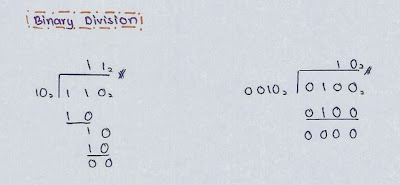Subtopic in this chapter:
# Operation on integer
* Addition and subtraction
* Multiplication and division
# Floating-point real number
* Representation and operations
OPERATION ON INTEGER
Example for Binary Addition
Example for Binary Substraction
Example for Binary Multiplication
Example for Binary Division
by Nor Izzati Binti Setopa
Example for Hexadecimal Addition
Example for Hexadecimal Substraction
Example for Hexadecimal Multiplication
Step Hexadecimal Multiplication:
- convert hexadecimal to decimal
- convert decimal to hexadecimal back
Example for Hexadecimal Division
Step Hexadecimal Division:
- convert hexadecimal to decimal first
- convert decimal to hexadecimal back
by Siti Nazirah Binti Abu Hasan
FLOATING-POINT REAL NUMBERS
________________________________________________________________________________
Floating Point Addition
8.70 × 10-1 with 9.95 × 101
1. Rewrite the smaller number such that its exponent matches
with the exponent of the larger number.
8.70 × 10-1 = 0.087 × 101
2. Add the
mantissas
9.95 + 0.087 = 10.037 and write the sum 10.037 × 101
3. Put the result
in Normalised Form
10.037 × 101 = 1.0037 × 102 (shift
mantissa, adjust exponent)
check for overflow/underflow of the exponent after normalisation
4. Round the
result
If the mantissa
does not fit in the space reserved for it, it has to be rounded off.
For Example: If
only 4 digits are allowed for mantissa
1.0037 × 102 ===> 1.004 × 102
(only have a hidden bit with binary floating point
numbers)
____________________________________________________________
Example addition in binary
Perform 0.5 + (-0.4375)
0.5 = 0.1 × 20 = 1.000 × 2-1 (normalised)
-0.4375 = -0.0111 × 20 = -1.110 × 2-2 (normalised)
- Rewrite the smaller number such that its exponent matches with the exponent of the larger number.
-1.110 × 2-2 = -0.1110 × 2-1 - Add the mantissas:
1.000 × 2-1 + -0.1110 × 2-1 = 0.001 × 2-1 - Normalise the sum, checking for overflow/underflow:
0.001 × 2-1 = 1.000 × 2-4-126 <= -4 <= 127 ===> No overflow or underflow - Round the sum:
The sum fits in 4 bits so rounding is not requiredCheck: 1.000 × 2-4 = 0.0625 which is equal to 0.5 - 0.4375
Correct!
______________________________________________________________________
Floating Point Multiplication
Multiply the following two numbers in scientific notation by hand:
1.110 × 1010 × 9.200 × 10-5
- Add the exponents to find
New Exponent = 10 + (-5) = 5If we add biased exponents, bias will be added twice. Therefore we need to subtract it once to compensate:
(10 + 127) + (-5 + 127) = 259
259 - 127 = 132 which is (5 + 127) = biased new exponent - Multiply the mantissas
1.110 × 9.200 = 10.212000Can only keep three digits to the right of the decimal point, so the result is
10.212 × 105 - Normalise the result
1.0212 × 106 - Round it
1.021 × 106
___________________________________________________________________________________________
Example multiplication in binary:
1.000 × 2-1 × -1.110 × 2-2
- Add the biased exponents
(-1 + 127) + (-2 + 127) - 127 = 124 ===> (-3 + 127) - Multiply the mantissas
1.000 × 1.110 ----------- 0000 1000 1000 + 1000 ----------- 1110000 ===> 1.110000The product is 1.110000 × 2-3 Need to keep it to 4 bits 1.110 × 2-3 - Normalise (already normalised)
At this step check for overflow/underflow by making sure that
-126 <= Exponent <= 1271 <= Biased Exponent <= 254 - Round the result (no change)
- Adjust the sign.
Since the original signs are different, the result will be negative-1.110 × 2-3
_____________________________________________________________________________________________
by Robael Adawiyah dan Wan Nur Ulaiya
Floating Point Standart IEEE 754
by Siti Hajar
Floating Point Standart IEEE 754
by Siti Hajar
source:
- Lecture note COA 2013
- Lab companion COA Edition 2013
- http://www.doc.ic.ac.uk/~eedwards/compsys/float/
- http://www.youtube.com/watch?v=MIrQtuoT5Ak













.jpg)
.jpg)
.jpg)